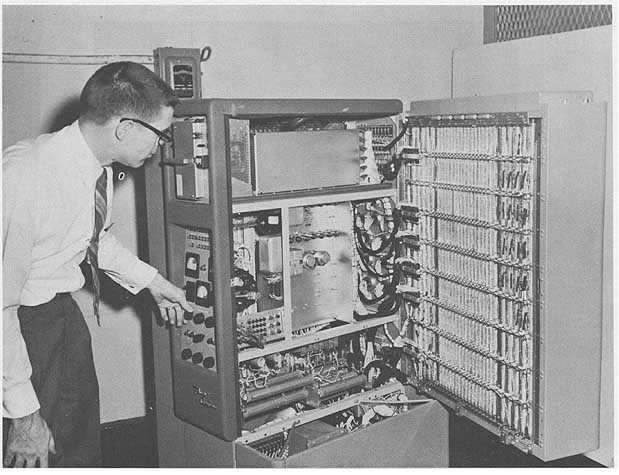Bendix G-15 Architecture
The Bendix G-15D represented an architectural dead end. Only a few later commercial computers, such as the Packard Bell PB 250, followed the same lines, and none of them were as successful as the first-generation G-15 and LGP-30. Even Bendix went to an architecture much closer to Intercom than to the G-15 for their transistorized computer, the G-20 (which also cost 10 times as much).
So the G-15 architecture is interesting today primarily as an example of how optimizing for recirculating memory and vacuum-tube plus diode logic leads to very different trade-offs than for random-access memory and transistor logic.
Vacuum tubes took a lot of space (over a cubic inch apiece), used a lot of power (several watts), and were the most failure-prone class of component. A flip-flop took two tubes (but provided both the signal and its negation), logical not could be done with one tube, and boolean expressions in disjunctive normal form (ors of ands) could be done purely with germanium diodes and resistors. So evaluating complicated boolean expressions was a lot cheaper than remembering something from one "bit time" to the next.
However, I have a different motivation for discussing some of its characteristics in this blog: It will set context for some of the stories I have to tell.

Photo by The Martin Company, Baltimore
The 26 neon lights (grouped above the various meters and knobs) displayed essentially all the non-recirculating state (held in vacuum tube flip-flops) visible to the programmer, and were heavily used for debugging.
Also note the punched paper tape emerging from near the top of the machine, just above the paper tape cassette.

Photo by U. S. Army Map Service
(Both photos are links to Ed Thelen's excellent historical site.)

So the G-15 architecture is interesting today primarily as an example of how optimizing for recirculating memory and vacuum-tube plus diode logic leads to very different trade-offs than for random-access memory and transistor logic.
Vacuum tubes took a lot of space (over a cubic inch apiece), used a lot of power (several watts), and were the most failure-prone class of component. A flip-flop took two tubes (but provided both the signal and its negation), logical not could be done with one tube, and boolean expressions in disjunctive normal form (ors of ands) could be done purely with germanium diodes and resistors. So evaluating complicated boolean expressions was a lot cheaper than remembering something from one "bit time" to the next.
However, I have a different motivation for discussing some of its characteristics in this blog: It will set context for some of the stories I have to tell.

Photo by The Martin Company, Baltimore
The 26 neon lights (grouped above the various meters and knobs) displayed essentially all the non-recirculating state (held in vacuum tube flip-flops) visible to the programmer, and were heavily used for debugging.
Also note the punched paper tape emerging from near the top of the machine, just above the paper tape cassette.

Photo by U. S. Army Map Service
(Both photos are links to Ed Thelen's excellent historical site.)



0 Comments:
Post a Comment
<< The Way It Was home